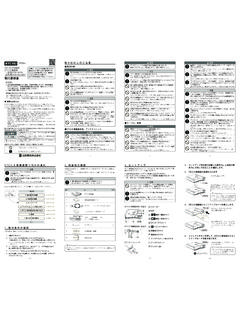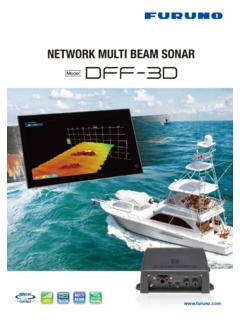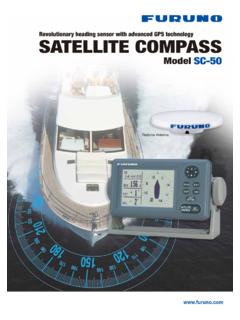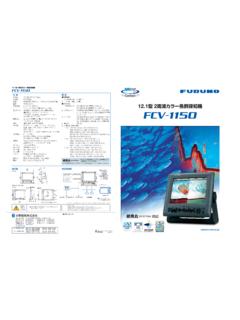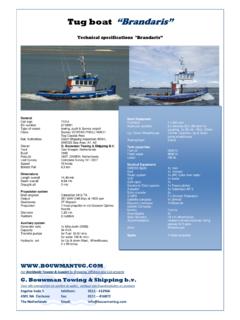Transcription of GMDSS GUIDE - furuno.com
1 All brand and product names are registered trademarks, trademarks or service marks of their respective SUBJECT TO CHANGE WITHOUT NOTICEFURUNO ELECTRIC CO., , Hyogo, , , Washington, (UK) LIMITEDH avant, Hampshire, NORGE A/S lesund, DANMARK A/S Hvidovre, SVERIGE ABV stra Fr lunda, FINLAND OYEspoo, POLSKA Sp. Z , DEUTSCHLAND GmbHRellingen, FRANCE rignac, ESPA A , ITALIA , ItalyFURUNO HELLAS , (CYPRUS) LTDL imassol, EURUS LLCSt. Petersburg, Russian SHANGHAI CO., , KOREA CO., , KoreaRICO (PTE) Printed in JapanCatalogue No. GC-019nSea AreaThe radiotelephone coverage of VHF coast stations in which continuous alerting by Digital Selective Calling (DSC) is AreaThe radiotelephone coverage of MF coast stations in which continuous alerting by Digital Selective Calling is AreaThe coverage of Inmarsat geostationary AreaArea outside A1, A2 and A3, mostly sea area around polar areasGENERAL CONCEPT OF GMDSSGENERAL CONCEPT OF GMDSSG lobal Maritime Distress and Safety System ( GMDSS ) has been developed by the maritime nations in the International Maritime Organization (IMO) and is the result of their adoption of amendments made in 1988 to the 1974 International Convention on the Safety of Life at Sea (SOLAS).
2 Based on recent developments in maritime communications, such as satellites and digital technology, GMDSS is designed to ensure maximum availability of safety-related communication for all passenger ships as well as for cargo vessels of 300 GT and upwards engaged in international voyages.*The goal of GMDSS is to virtually guarantee that complying vessels will be able to communicate with an onshore station at any time, from any location, in case of distress or to exchange safety-related information.*Ships below 300 gross tonnage as well as those that are not engaged in international voyages are subject to the requirements of the administrations of their flag AREASGMDSS defines four sea areas based upon the location and capability of onshore-based communication facilities.
3 The definition of the Sea Areas for GMDSS is outlined below. Please refer to the illustrated layout of the European area indicating the sea areas and coastal stations for quick : European GMDSS SEA AREASGMDSS Sea AreasMedium Frequency (MF), High Frequency (HF) andVery High Frequency (VHF) Coast Radio StationMedium Frequency (MF) and Very High Frequency (VHF) Coast Radio StationVery High Frequency (VHF) Coast Radio StationComparison between old distress system and GMDSSR eliance on ships in vicinitySpecial skill to operateWorldwide coverageSimple and automatic operationEquipment compatibilityBecause of the inherently limited range of transmission on the distress and calling frequencies of 500 and 2182 kHz, which were commonly used for that purpose, there was a possibility that a call for assistance would not be heard if other vessels and coastal stations were outside the was only possible for a vessel in distress to ask other vessels in the vicinity for assistance, due to the limited range of communication means.
4 Worse, the communication incompatibility between a telegraphy vessel and a telephony vessel hindered subsequent Search and Rescue officers had to send distress calls in Morse Code on 500 kHz through complicated operations, which include: switching and/or adjusting the transmitters. A successful distress attempt relied heavily on the skill of the radio officers. GMDSS vessels carry the communications equipment appropriate for the Sea Area they are operating, and have the means to transmit long-range communication whenever necessary. This means that a call for assistance can reach a coastal station, and other ships at a far all GMDSS vessels carry standardized equipment for the Sea Area, and they are operating in the same frequencies, the compatibility between the SAR coordinator at a coastal station and a vessel is equipment, on the other hand, provides straightforward operation in time of emergency simply by pressing the distress button on the VHF, MF/HF DSC or Inmarsat MES.
5 If this cannot be done, a float-free EPIRB can transmit a distress AreaThe radiotelephone coverage of VHF coast stations in which continuous alerting by Digital Selective Calling (DSC) is AreaThe radiotelephone coverage of MF coast stations in which continuous alerting by Digital Selective Calling is AreaThe coverage of Inmarsat geostationary AreaArea outside A1, A2 and A3, mostly sea area around polar areasGENERAL CONCEPT OF GMDSSGENERAL CONCEPT OF GMDSSG lobal Maritime Distress and Safety System ( GMDSS ) has been developed by the maritime nations in the International Maritime Organization (IMO) and is the result of their adoption of amendments made in 1988 to the 1974 International Convention on the Safety of Life at Sea (SOLAS).
6 Based on recent developments in maritime communications, such as satellites and digital technology, GMDSS is designed to ensure maximum availability of safety-related communication for all passenger ships as well as for cargo vessels of 300 GT and upwards engaged in international voyages.*The goal of GMDSS is to virtually guarantee that complying vessels will be able to communicate with an onshore station at any time, from any location, in case of distress or to exchange safety-related information.*Ships below 300 gross tonnage as well as those that are not engaged in international voyages are subject to the requirements of the administrations of their flag AREASGMDSS defines four sea areas based upon the location and capability of onshore-based communication facilities.
7 The definition of the Sea Areas for GMDSS is outlined below. Please refer to the illustrated layout of the European area indicating the sea areas and coastal stations for quick : European GMDSS SEA AREASGMDSS Sea AreasMedium Frequency (MF), High Frequency (HF) andVery High Frequency (VHF) Coast Radio StationMedium Frequency (MF) and Very High Frequency (VHF) Coast Radio StationVery High Frequency (VHF) Coast Radio StationComparison between old distress system and GMDSSR eliance on ships in vicinitySpecial skill to operateWorldwide coverageSimple and automatic operationEquipment compatibilityBecause of the inherently limited range of transmission on the distress and calling frequencies of 500 and 2182 kHz, which were commonly used for that purpose, there was a possibility that a call for assistance would not be heard if other vessels and coastal stations were outside the was only possible for a vessel in distress to ask other vessels in the vicinity for assistance, due to the limited range of communication means.
8 Worse, the communication incompatibility between a telegraphy vessel and a telephony vessel hindered subsequent Search and Rescue officers had to send distress calls in Morse Code on 500 kHz through complicated operations, which include: switching and/or adjusting the transmitters. A successful distress attempt relied heavily on the skill of the radio officers. GMDSS vessels carry the communications equipment appropriate for the Sea Area they are operating, and have the means to transmit long-range communication whenever necessary. This means that a call for assistance can reach a coastal station, and other ships at a far all GMDSS vessels carry standardized equipment for the Sea Area, and they are operating in the same frequencies, the compatibility between the SAR coordinator at a coastal station and a vessel is equipment, on the other hand, provides straightforward operation in time of emergency simply by pressing the distress button on the VHF, MF/HF DSC or Inmarsat MES.
9 If this cannot be done, a float-free EPIRB can transmit a distress **For areas where there is no coastal radio station handling MF/HF general communications, Inmarsat-C mobile earth station may be used to fulfill the requirement for general radiotelephone with built-in DSC/DSC Watch ReceiverCarriage/functional requirements for GMDSSG eneral functional requirements for GMDSSS ystem suggestions for GMDSS General requirement for equipment and functions for all ships irrespective of the operating sea areaAdditional equipment to be installed on ships operating in the Sea Areas:Maintenance requirement for ships operating in Sea Area andTwo-way VHF radiotelephone apparatusInmarsat EGC receiverArrangements required only for all passenger shipsVHF radiotelephone with DSC and DSC Watch Receiver capable of:Functional requirements to be fulfilled by FS-xx75:Other functional requirementsInternational NAVTEX ReceiverA distress panel at the conning positionIf the satellite EPIRB is used as the secondary means of distress alerting and not remotely activated, it is acceptable to have an additional EPIRB installed close to the conning and rescue locating device (SART.)
10 Either by radar transponder operating in the 9 GHz band or AIS-SART)406 MHz EPIRBAt least two two-way VHF radiotelephone apparatus required for cargo ships of 300-500 GTAt least three two-way VHF radiotelephone apparatus required for all passenger ships and cargo ships of 500 GT and upwards Note: There is no additional equipment required for ships operating exclusively in the Sea Area A1 Required if the ships operate within Inmarsat coverage but outside the international NAVTEX service area. However, ships operating exclusively in areas where an HF direct-printing telegraphy maritime safety information service is provided and fitted with equipment capable of receiving such service may be exempted from this radiotelephone for on-scene search and rescue communication using frequencies MHz and MHzPermanently arranged electrical lighting for illuminating the control panel of the radiocommunications equipmentAutomatic provision of position from an internal or external navigation sensor for all two-way communication equipment that includes ship's position in the distress alertAutomatic and continuous update of position for all relevant radiocommunication equipment to be included in the initial distress alert
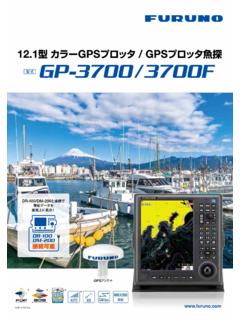
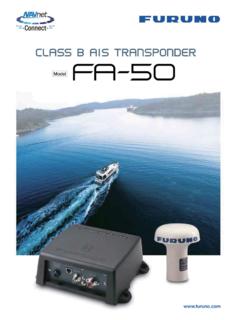
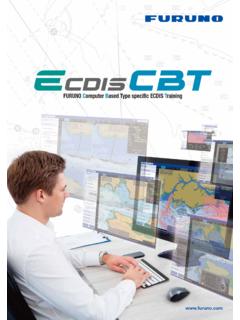
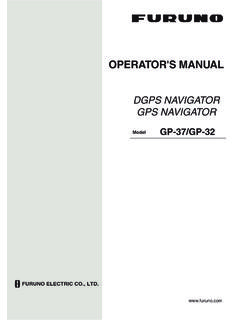

![ETC2.0車載器 [業務用]FNK-M100BV 取扱説明書](/cache/preview/0/c/b/1/1/9/a/a/thumb-0cb119aab88f8b3966759054c45d5ca2.jpg)
